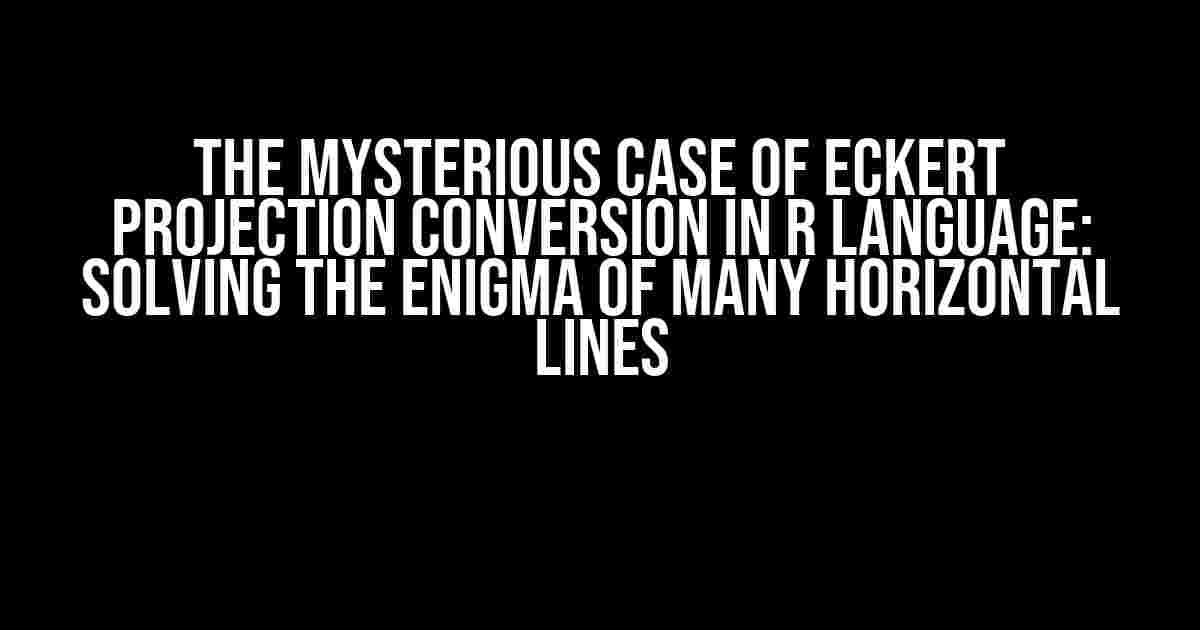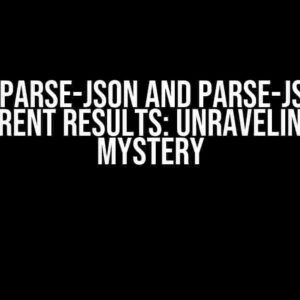If you’re an R language enthusiast, you’ve probably stumbled upon the Eckert projection conversion Conundrum. You know, that frustrating issue where converting longitude values from -180 to 180 to 0 to 360 degrees results in an abundance of unwanted horizontal lines in your otherwise stunning map visualizations. Fear not, dear reader, for we’re about to embark on a thrilling adventure to vanquish this nuisance and unearth the secrets of Eckert projection conversion in R language!
The Problem: A Plethora of Horizontal Lines
Let’s set the stage. You’re working on a mapping project, and you need to convert your longitude values from the -180 to 180 range to the 0 to 360 range to ensure seamless compatibility with the Eckert projection. You fire up your trusty R console, ready to tackle the task. But, oh dear reader, as you execute the conversion, a swarm of horizontal lines suddenly appears, marring your beautifully crafted map. The question is, why?
The Culprit: Longitude Conversion Gone Wrong
The root of the issue lies in the incorrect conversion of longitude values. When you convert -180 to 180 to 0 to 360, R language interprets the negative values as separate entities, resulting in the creation of multiple horizontal lines. It’s as if R is saying, “Hey, I see a bunch of negative numbers; I’ll just create a new line for each one!”
library(ggmap)
library(ggplot2)
# Sample data
df <- data.frame(longitude = c(-120, -100, -80, -60, -40, -20, 0, 20, 40, 60, 80, 100, 120),
latitude = rep(0, 13))
# Convert longitude values from -180 to 180 to 0 to 360
df$longitude <- ifelse(df$longitude < 0, 360 + df$longitude, df$longitude)
# Plot the data
ggmap::get_map(location = c(0, 0), zoom = 1) +
geom_point(data = df, aes(x = longitude, y = latitude), color = "red") +
theme_void()
The code above demonstrates the conversion process, but, as you can see, it yields an unsightly map with numerous horizontal lines. Don’t worry; we’re about to learn the secrets to correcting this issue.
The Solution: Employing the Modulo Operator
The modulo operator (%) is our trusty sidekick in this adventure. By using it to adjust the longitude values, we can elegantly sidestep the horizontal line conundrum.
library(ggmap)
library(ggplot2)
# Sample data
df <- data.frame(longitude = c(-120, -100, -80, -60, -40, -20, 0, 20, 40, 60, 80, 100, 120),
latitude = rep(0, 13))
# Convert longitude values from -180 to 180 to 0 to 360 using modulo operator
df$longitude <- (df$longitude + 180) %% 360 - 180
# Plot the data
ggmap::get_map(location = c(0, 0), zoom = 1) +
geom_point(data = df, aes(x = longitude, y = latitude), color = "red") +
theme_void()
Voilà! The resulting map is now free from the pesky horizontal lines. By adding 180 to the longitude values and then using the modulo operator to ensure they fall within the 0 to 360 range, we’ve successfully overcome the Eckert projection conversion hurdle.
Understanding the Modulo Operator Magic
The modulo operator (%) returns the remainder of the division of two numbers. In our case, we add 180 to the longitude values, which shifts the entire range to 0 to 360. Then, we use the modulo operator to “wrap around” values greater than 360 to their equivalent positions within the 0 to 360 range.
| Longitude (-180 to 180) | Longitude (add 180) | Longitude (modulo 360) |
|---|---|---|
| -120 | 60 | 60 |
| -100 | 80 | 80 |
| -80 | 100 | 100 |
| -60 | 120 | 120 |
| -40 | 140 | 140 |
| -20 | 160 | 160 |
| 0 | 180 | 180 |
| 20 | 200 | 20 |
| 40 | 220 | 40 |
| 60 | 240 | 60 |
| 80 | 260 | 80 |
| 100 | 280 | 100 |
| 120 | 300 | 120 |
By applying the modulo operator, we ensure that values originally in the -180 to 0 range are correctly mapped to their equivalent positions within the 0 to 360 range, eliminating the pesky horizontal lines.
Best Practices for Eckert Projection Conversion
To avoid the horizontal line conundrum in the future, remember to:
- Always use the modulo operator to adjust longitude values when converting from -180 to 180 to 0 to 360.
- Verify that your longitude values are within the correct range before plotting.
- Use the correct projection type (Eckert, in this case) when plotting your data.
Conclusion
With the modulo operator as our trusty sidekick, we’ve triumphed over the Eckert projection conversion hurdle. By following the best practices outlined above, you’ll be well on your way to creating stunning, horizontal-line-free maps in R language. Remember, a clever use of the modulo operator can make all the difference in your mapping adventures!
Now, go forth and map like a pro!
Frequently Asked Question
Get ready to unravel the mysteries of R language drawing Eckert projection conversion! Below, we’ve got the scoop on those pesky horizontal lines that appear when converting from 180 to 180 to 0 to 360. Dive in and get enlightened!
What is the Eckert projection conversion, and why is it used in R language?
The Eckert projection is a way to project the Earth’s surface onto a 2D plane, preserving shapes and sizes well. In R language, it’s used for visualizing geographic data, especially for creating world maps. When converting longitude values from 180 to 180 to 0 to 360, Eckert projection helps maintain the correct geometry and scaling.
Why do many horizontal lines appear when converting from 180 to 180 to 0 to 360 in Eckert projection?
These horizontal lines are an artifact of the projection process. When converting longitude values, some points may be projected to multiple locations on the 2D plane, resulting in duplicate horizontal lines. This is especially true when dealing with lines crossing the 180° meridian or the International Date Line.
How can I remove these unwanted horizontal lines in R language?
To eliminate these lines, try using the mergeLines function from the maptools package in R. This function can merge overlapping lines, removing duplicates and resulting in a cleaner map. Alternatively, you can also use the sp package and its functions to simplify and remove redundant lines.
Are there any other projection options in R language that can avoid these horizontal lines?
Yes! R language offers various projection options, such as the Mercator, Robinson, or Gall-Peters projections. These projections can reduce or eliminate the horizontal lines, depending on the specific application and data requirements. Experiment with different projections to find the best fit for your use case.
What are some best practices for working with Eckert projection conversion in R language?
When working with Eckert projection conversion, it’s essential to understand the underlying data and projection principles. Be mindful of line crossings, especially near the 180° meridian. Use the maptools package for line merging, and consider alternative projections for specific use cases. Lastly, always verify the accuracy of your maps by comparing them to reliable sources.




